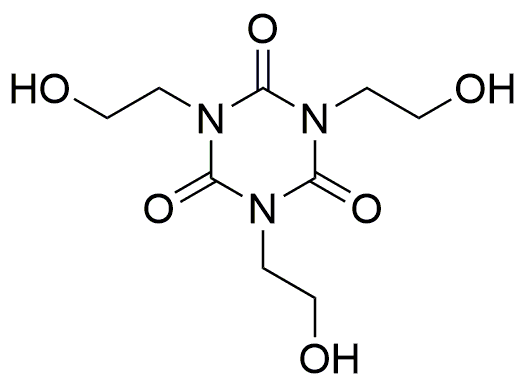Tris(2-hydroxyethyl) isocyanurate is widely utilized in research focused on:
- Polymer Production: This compound serves as a crosslinking agent in the manufacturing of thermosetting resins and coatings, enhancing durability and heat resistance in products like adhesives and sealants.
- Textile Industry: It is applied in textile finishing processes to improve the water-repellency and stain resistance of fabrics, making them more suitable for outdoor and high-performance applications.
- Cosmetic Formulations: Used as a stabilizer in personal care products, it helps maintain the integrity and effectiveness of active ingredients, ensuring longer shelf life and better performance.
- Water Treatment: This chemical acts as a biocide in water treatment applications, effectively controlling microbial growth in swimming pools and industrial water systems, thereby improving safety and hygiene.
- Pharmaceuticals: In drug formulation, it serves as a stabilizing agent, enhancing the solubility and bioavailability of active pharmaceutical ingredients, which is crucial for effective medication delivery.
Información general
Propiedades
Seguridad y normativas
Aplicaciones
Tris(2-hydroxyethyl) isocyanurate is widely utilized in research focused on:
- Polymer Production: This compound serves as a crosslinking agent in the manufacturing of thermosetting resins and coatings, enhancing durability and heat resistance in products like adhesives and sealants.
- Textile Industry: It is applied in textile finishing processes to improve the water-repellency and stain resistance of fabrics, making them more suitable for outdoor and high-performance applications.
- Cosmetic Formulations: Used as a stabilizer in personal care products, it helps maintain the integrity and effectiveness of active ingredients, ensuring longer shelf life and better performance.
- Water Treatment: This chemical acts as a biocide in water treatment applications, effectively controlling microbial growth in swimming pools and industrial water systems, thereby improving safety and hygiene.
- Pharmaceuticals: In drug formulation, it serves as a stabilizing agent, enhancing the solubility and bioavailability of active pharmaceutical ingredients, which is crucial for effective medication delivery.
Documentos
Hojas de datos de seguridad (HDS)
La SDS proporciona información de seguridad completa sobre la manipulación, el almacenamiento y la eliminación del producto.
Especificación del producto (PS)
La PS proporciona un desglose completo de las propiedades del producto, incluida la composición química, el estado físico, la pureza y los requisitos de almacenamiento. También detalla los rangos de calidad aceptables y las aplicaciones previstas del producto.
Certificados de análisis (COA)
Busque certificados de análisis (COA) ingresando el número de lote del producto. Los números de lote y de partida se pueden encontrar en la etiqueta de un producto después de las palabras "Lote" o "Lote".
Número de catálogo
Número de lote/lote
Certificados de origen (COO)
Este certificado de origen confirma el país en el que se fabricó el producto y también detalla los materiales y componentes utilizados en él y si se deriva de fuentes naturales, sintéticas u otras fuentes específicas. Este certificado puede ser necesario para cumplir con las normativas aduaneras, comerciales y regulatorias.
Número de catálogo
Número de lote/lote
Hojas de datos de seguridad (HDS)
La SDS proporciona información de seguridad completa sobre la manipulación, el almacenamiento y la eliminación del producto.
DownloadEspecificación del producto (PS)
La PS proporciona un desglose completo de las propiedades del producto, incluida la composición química, el estado físico, la pureza y los requisitos de almacenamiento. También detalla los rangos de calidad aceptables y las aplicaciones previstas del producto.
DownloadCertificados de análisis (COA)
Busque certificados de análisis (COA) ingresando el número de lote del producto. Los números de lote y de partida se pueden encontrar en la etiqueta de un producto después de las palabras "Lote" o "Lote".
Número de catálogo
Número de lote/lote
Certificados de origen (COO)
Este certificado de origen confirma el país en el que se fabricó el producto y también detalla los materiales y componentes utilizados en él y si se deriva de fuentes naturales, sintéticas u otras fuentes específicas. Este certificado puede ser necesario para cumplir con las normativas aduaneras, comerciales y regulatorias.


